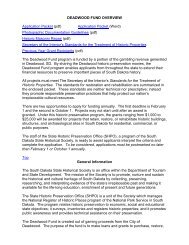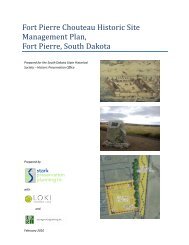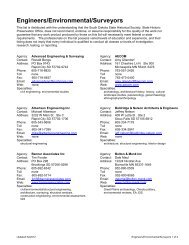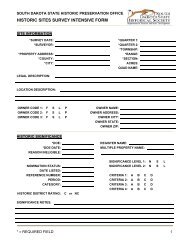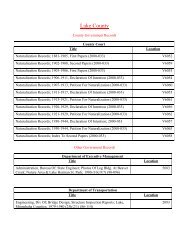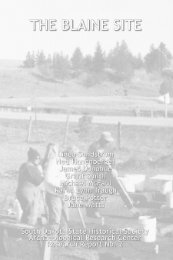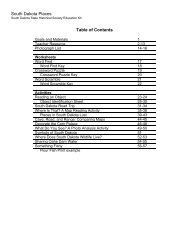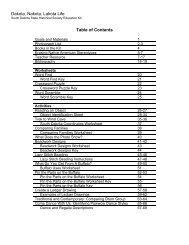A Geoarchaeological Overview of South Dakota and Preliminary
A Geoarchaeological Overview of South Dakota and Preliminary
A Geoarchaeological Overview of South Dakota and Preliminary
Create successful ePaper yourself
Turn your PDF publications into a flip-book with our unique Google optimized e-Paper software.
DRAFT DRAFT DRAFT<br />
integrity <strong>of</strong> deposits that are encountered. Eigenberger et al. (2009) provide a useful approach to<br />
evaluating buried site potential. Their categories are quoted here, <strong>and</strong> discussed extensively in a<br />
subsequent section, Concepts <strong>and</strong> Considerations, below.<br />
“High Potential: depositional processes are…conducive to preserving buried archaeological deposits<br />
in primary context <strong>and</strong> have the potential for separation <strong>of</strong> archaeological components.<br />
“Moderate Potential: depositional processes … are conducive to preserving buried archaeological<br />
deposits but with possible physical modifications to the primary context [i.e., eroded or otherwise<br />
disturbed].<br />
“Low Potential: deposits... are too old or too thin to contain buried archaeological deposits in primary<br />
contexts or… accumulated in high-energy depositional environments (fluvial channels, for example)<br />
where archaeological deposits would not survive in primary context” (Eigenberger et al. 2009:3-3).<br />
These definitions have the advantage <strong>of</strong> being based primarily on geological processes as they relate<br />
to habitability <strong>and</strong> post-occupational preservation <strong>of</strong> l<strong>and</strong>forms. The same general concepts are used by<br />
geoarchaeologists throughout the United States. Indeed, Eigenberger et al. (2009) state that their criteria<br />
are based on those <strong>of</strong> Hudak <strong>and</strong> Hajic (2008), working in Minnesota, Hajic (2008) working in <strong>South</strong><br />
<strong>Dakota</strong>, <strong>and</strong> Mayer <strong>and</strong> McFaul (2008), working in Wyoming.<br />
In addition to developing buried site potential criteria, Eigenberger et al. (2009) compiled a useful list<br />
<strong>of</strong> Quaternary sedimentary l<strong>and</strong>scapes <strong>and</strong> l<strong>and</strong>forms found along the “New Build” section <strong>of</strong> the<br />
proposed DM&E railroad in the <strong>South</strong> Fork Cheyenne Region (OSA-0004 in Figure 2). For each<br />
l<strong>and</strong>form, the dominant depositional processes were identified, along with the l<strong>and</strong>form’s buried site<br />
potential. Table 4, adapted from Eigenberger et al. (2009: Table 1), exp<strong>and</strong>s their approach to include<br />
the rest <strong>of</strong> <strong>South</strong> <strong>Dakota</strong>.<br />
As used here, a l<strong>and</strong>scape is a mosaic <strong>of</strong> l<strong>and</strong>forms. In Table 4, l<strong>and</strong>scapes are grouped into Upl<strong>and</strong><br />
<strong>and</strong> Stream Valley categories. L<strong>and</strong>forms in river, creek, <strong>and</strong> canyon l<strong>and</strong>scapes are primarily late<br />
Wisconsinan <strong>and</strong> Holocene in age, <strong>and</strong> thus their alluvial, eolian, <strong>and</strong> colluvial l<strong>and</strong>forms all have some<br />
degree <strong>of</strong> buried site potential. In upl<strong>and</strong> l<strong>and</strong>scapes, l<strong>and</strong>forms vary considerably in the presence,<br />
thickness <strong>of</strong> l<strong>and</strong>forms <strong>of</strong> Holocene-age l<strong>and</strong>forms <strong>and</strong> deposits that must be considered in evaluating<br />
buried site potential.<br />
Many l<strong>and</strong>forms are present in more than one l<strong>and</strong>scape. Table 5 lists the unique l<strong>and</strong>forms identified<br />
in Table 4. Each is briefly defined <strong>and</strong> discussed below. Detailed information on l<strong>and</strong>forms <strong>and</strong><br />
geological processes can be found in numerous sources, but that by Waters (1992) is both<br />
comprehensive <strong>and</strong> explicitly geoarchaeological in its perspective.<br />
Eolian Environments<br />
Dunes are comprised <strong>of</strong> windblown s<strong>and</strong> that builds to heights <strong>of</strong> several meters. In the S<strong>and</strong> Hills<br />
region, dunes can be up to 90 m thick (Martin et al. 2004). The low lying areas between dune crests are<br />
called interdunes. Some interdunal areas are deflationary, that is, cleared <strong>of</strong> dune s<strong>and</strong> by wind, leaving<br />
behind a lag <strong>of</strong> coarse s<strong>and</strong> <strong>and</strong> gravel, <strong>of</strong>ten on a bare bedrock surface. Depositional interdunes contain<br />
eolian s<strong>and</strong>s deposited by wind, or avalanched down dune slopes. In the S<strong>and</strong> Hills, wetl<strong>and</strong>s sometimes<br />
form in the interdunal areas, fed by groundwater that percolates down, then laterally, through the dune<br />
field. Dunes may advance over these wetl<strong>and</strong>s, burying them. Eigenberger et al. (2009) classified the<br />
archaeological potential <strong>of</strong> dunes as high, probably because <strong>of</strong> their thickness <strong>and</strong> Holocene age.<br />
However, when active, the windward side <strong>of</strong> the dunes is subject to deflation, with the s<strong>and</strong> blowing up<br />
<strong>and</strong> over the crest onto the advancing face <strong>of</strong> the dune. Thus sites within dunes are sometimes deflated<br />
(Waters 1992:195-200). To the author’s knowledge, dunes have not been the subject <strong>of</strong><br />
geoarchaeological investigation in <strong>South</strong> <strong>Dakota</strong>.<br />
20





